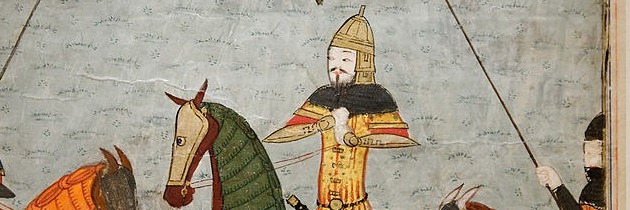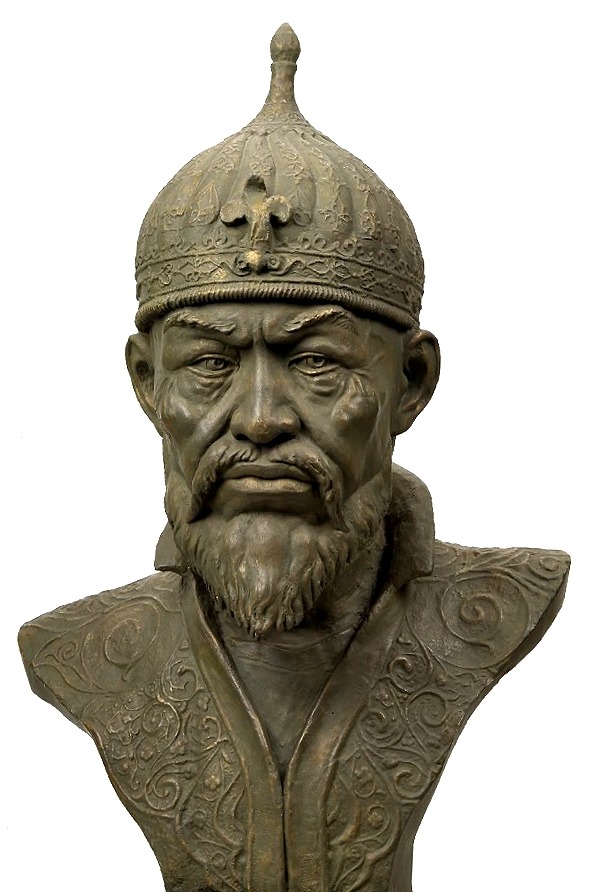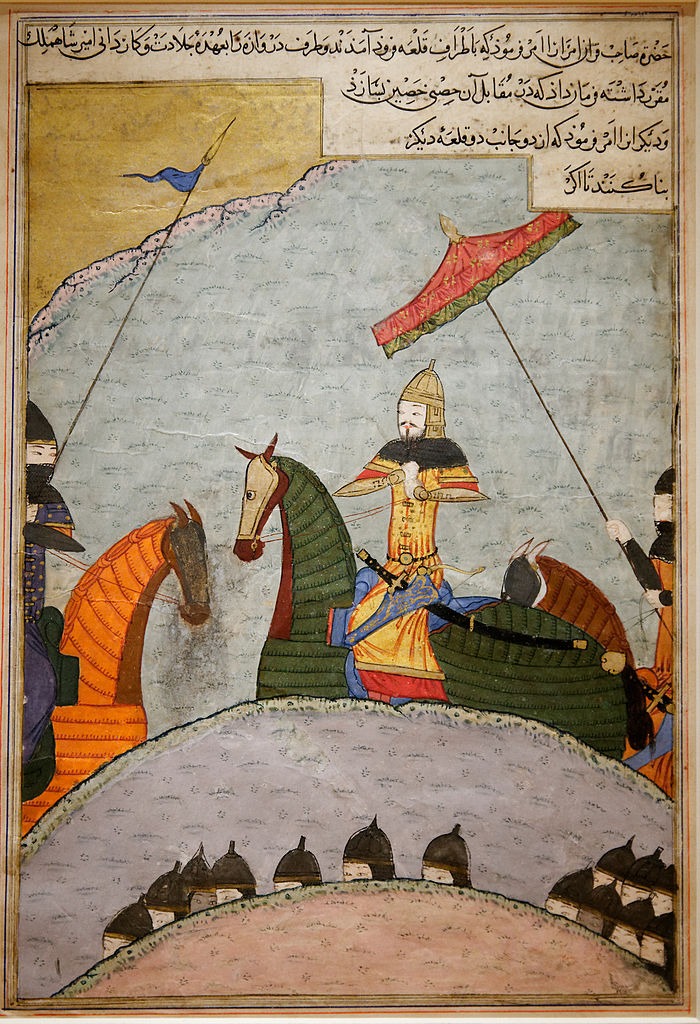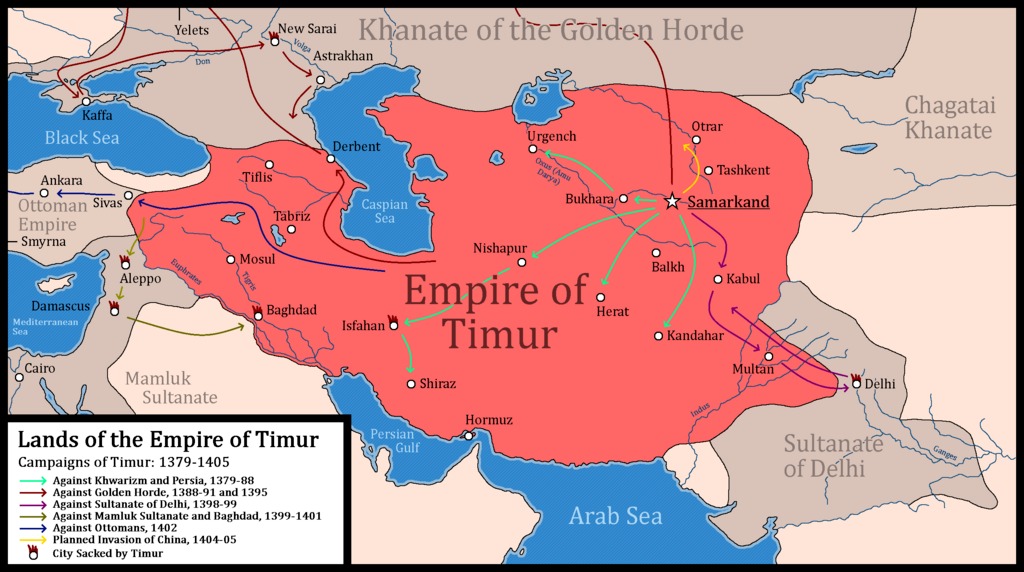Regarded as one of the greatest military leaders of all time, but also among the most brutal, Timur is the only Mongolian conqueror who came close to reach the power of Genghis Khan. His conquests during the late 14th century united a large portion of Asia, and his rule coincided with the flourishing of art and architecture in this region, an era known as the Timurid Renaissance.
Timur was born in 1336 near the city of Kesh, modern-day Shahrisabz in Uzbekistan. Then known as Transoxiana, this region was part of the Chagatai Khanate, one of the states that emerged from the division of the Mongolian Empire. Timur was a member of the Barlas, a tribe of Mongolian origin that had been turkified and converted to Islam. Timur shared an ancestor with Genghis Khan, as both descended from a Mongolian leader named Tumbinai Khan.
Modern reconstruction of Timur’s face (Shakko, Wikimedia Commons, CC BY-SA 3.0).
Timur emerged as a military leader around 1360, and by 1363 he took control of the entire region of Transoxiana. He then began to expand his territory, taking Samarkand, in modern-day Uzbekistan, in 1366 and Balkh, now in Afghanistan, in 1370. Having control over the most important cities in the region, Timur established the Timurid Empire in 1370, with Samarkand as its capital. Despite his success, he couldn’t claim the title of leader of all the Mongols, or Khan, because he wasn’t a direct descendant of Genghis Khan. Similarly, he also couldn’t be the leader of all the Muslims, of Caliph, because the title was reserved for the tribe of Muhammad. So, Timur took the title of Emir, a term of Arabic origin used for monarchs and high-ranking military officers.
After having consolidated his rule over Central Asia, Timur began expanding south, launching a campaign aimed at conquering Persia. At the time, Persia was divided among many small states after the fall of the Mongolian Ilkhanate in 1335, and Timur took advantage of this. He took over modern Afghanistan by capturing Herat in 1381 and Kandahar in 1383, and then moved west toward what is now Iran. Over the following years, the Timurid army ravaged Persia, leading to the fall of the various local dynasties that emerged after the division of the Ilkhanate. During his campaign, Timur destroyed the town of Esfezar, that had revolted against his rule, and all the survivors were cemented into the walls of the city.
After returning to Samarkand in 1386, Timur launched a campaign against Georgia, quickly taking over the country. He then proceeded to march toward Western Persia, to complete his conquest of the region. The largest city in the area, Isfahan, immediately surrended when Timur arrived there in 1387. However, the city soon revolted, and Timur recaptured it and ordered the massacre of most of the population, somewhere between 70,000 and 200,000 people. After the massacre, at least 28 towers with 1,500 heads each were constructed in the city.
Meanwhile, Tokhtamysh, ruler of the Golden Horde, launched an attack toward Persia in 1386. Timur responded five years later, marching from Central Asia toward modern-day Russia, and defeating Tokhtamysh near the Volga river in 1391. Timur then plundered various cities in southern Russia and Ukraine, and definitely defeated Tokhtamysh in 1395 in the North Caucasus. After this defeat, Tokhtamysh was deposed, and the Golden Horde entered a period of decline that soon led to its disintegration.
At the same time, the Delhi Sultanate in India was also crumbling, and this drew the attention of Timur. The Timurid army invaded the Indian subcontinent in 1398, and soon took over modern-day Pakistan. Just a few months later, in December 1398, Timur had reached Delhi. The city was sacked, and over 100,000 people were massacred, while the survivors were enslaved. This was one of Timur’s greatest victories, as Delhi was one of the richest cities in the world at the time. However, he had no intention to stay, and only looted the region before returning to its territory, leaving India devastated.
Timur leading his troops to the conquest of Baghdad in 1393, depicted in a manuscript from around 1435.
Afterwards, Timur began looking west, and set his sight to the rising Ottoman Empire in Anatolia, and the Mamluks of Egypt. In 1393, Timur had taken control of Baghdad, but the following year the Jalayirid Sultanate took back the city with the help of the Mamluks. Meanwhile, the Ottomans were expanding in Anatolia, including areas over nominal Timurid control. Timur launched his new campaign in 1399, and sacked Georgia and Armenia on route to Anatolia. After sacking Sivas, in central Turkey, he turned south to Mamluk-ruled Syria. In 1400, the Timurid army destroyed the cities of Aleppo and Damascus, massacring the inhabitants and sparing only artisans, who were deported to Samarkand. The following year, Timur took back Baghdad, and ordered that every soldier should return with at least two severed human heads. This resulted in the massacre of almost the entire population of the city.
Timur then marched toward Anatolia, and in 1402 he defeated the Ottomans in Ankara, capturing the Ottoman Sultan Bayezid I. This sparked a civil war known as the Ottoman Interregnum, which lasted until 1413. Timur put Mehmed I on the Ottoman throne, but his brothers challenged his authority. Only after a 11-year long war, Mehmed I managed to bring the Ottoman Empire under his control. Meanwhile, Timur continued west and reached Izmir on the coast of the Aegean Sea, which was ruled by the Knights Hospitaller. Once again, Timur not only took the city, but also massacred the population. Despite being sworn enemies, the Genoese and the Venetians helped Ottoman ships during this time, as they feared Timur even more.
After coming back from Anatolia, Timur began preparing for an invasion of China. Timur had been at odds with the Ming dynasty since 1394, when Chinese ambassadors presented him with a letter addressing him as a subject of the Ming. He launched his campaign in the winter, which was unusual for him, and he soon became ill. Timur died in Otrar, now in Kazakhstan, in February 1405, before even reaching the Chinese border.
Map of the Timurid Empire in 1405 and Timur’s main military campaigns (HetmanTheResearcher, Wikimedia Commons, CC BY 4.0).
Timur was succeeded by his grandson Pir Muhammad, but none of his family members supported him, and the empire descended into civil war. After the situation was stabilized, the Timurid Empire had already lost a lot of territory to foreign invaders, and in the late 15th century it began to disintegrate. The homeland of Timur passed under the rule of the Uzbeks of the Khanate of Bukhara, who took Samarkand in 1505. The Uzbeks then took Herat in 1507, and this marked the end of the Timurid Empire.
While none of Timur’s successors were able to reunite the empire, his great-great-great-grandson Babur at least lived up to the importance of his ancestor. After failing to take control of Central Asia, Babur moved to India and founded the Mughal Empire, which would go on to rule India until its fall to the British Empire in 1857.
The legacy of Timur is conflicting. He’s regarded as a national hero in Uzbekistan, and his mausoleum in Samarkand is an important landmark, as well as one of the greatest examples of Central Asian architecture. While Timur is celebrated in Central Asia, his image is very negative in all the regions that suffered from his atrocities, including Syria, Iraq, Iran, Georgia, and India. He’s regarded as a brutal but intelligent ruler by most historians, and surrounded himself with scholars. However, he often sacked other cities just to enrich Samarkand, leaving other territories neglected, and this led to the quick disintegration of his empire after his death.
Timur is credited with a revival of arts and science in the Muslim world, known as the Timurid Renaissance. He established the Persian language as the language of administration in Central Asia, leading Persian culture and literature to experience a very prosperous period. Timurid art and architecture blended the traditions of Iranian and Central Asian culture, and some of the greatest monuments in this region were built under Timur or his successors. The study of math and astronomy also flourished under Timur, while Samarkand and Herat became the main cultural centers of the Islamic world.




